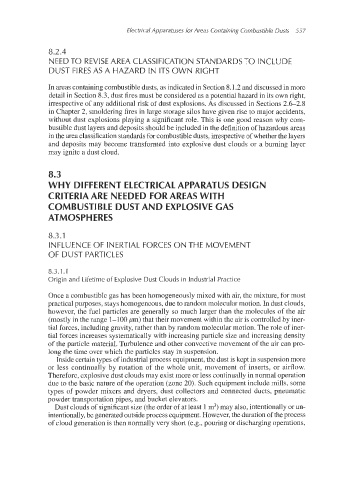Page 590 - Dust Explosions in the Process Industries
P. 590
ElectricalApparatuses for Areas Containing Combustible Dusts 557
8.2.4
NEED TO REVISE AREA CLASSIFICATION STANDARDS TO INCLUDE
DUST FIRES AS A HAZARD IN ITS OWN RIGHT
In areas containing combustible dusts, as indicated in Section 8.1.2 and discussedin more
detail in Section 8.3, dust fires must be considered as a potential hazard in its own right,
irrespective of any additional risk of dust explosions.As discussed in Sections 2.6-2.8
in Chapter 2, smoldering fires in large storage silos have given rise to major accidents,
without dust explosions playing a significant role. This is one good reason why com-
bustible dust layers and deposits should be included in the definition of hazardous areas
in the area classification standardsfor combustibledusts,irrespectiveof whether the layers
and deposits may become transformed into explosive dust clouds or a burning layer
may ignite a dust cloud.
8.3
HY DIFFERENT ELECTRICAL APPARATUS DESIGN
CRITERIA ARE NEEDED FOR AREAS WITH
COMBUSTIBLE DUST AND EXPLOSIVE GAS
ATMOSPHERES
8.3.1
INFLUENCE OF INERTIAL FORCES ON THE MOVEMENT
OF DUST PARTICLES
8.3.1.I
Origin and Lifetime of Explosive Dust Clouds in Industrial Practice
Once a combustible gas has been homogeneouslymixed with air, the mixture, for most
practicalpurposes, stays homogeneous, due to random molecular motion. In dust clouds,
however, the fuel particles are generally so much larger than the molecules of the air
(mostly in the range 1-100 pm) that their movement within the air is controlledby iner-
tial forces, including gravity, rather than by random molecular motion. The role of iner-
tial forces increases systematically with increasing particle size and increasing density
of the particle material. Turbulence and other convective movement of the air can pro-
long the time over which the particles stay in suspension.
hide certain types of industrialprocess equipment,the dust is kept in suspensionmore
or less continually by rotation of the whole unit, movement of inserts, or airflow.
Therefore, explosive dust clouds may exist more or less continuallyin normal operation
due to the basic nature of the operation (zone 20). Such equipment include mills, some
types of powder mixers sand dryers, dust collectors and connected ducts, pneumatic
powder transportation pipes, and bucket elevators.
Dust clouds of significant size (the order of at least 1 m3)may also,intentionally or un-
intentionally,be generated outsideprocess equipment. However, the duration of the process
of cloud generation is then normally very short (e.g., pouring or dischargingoperations,

